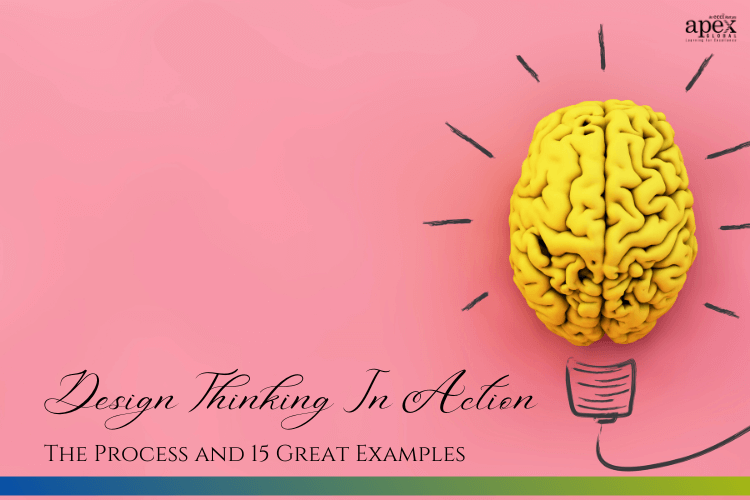If you’ve heard of design thinking, you may know that it’s an ideology used to solve complex problems in a creative, user-centric way.
But what does design thinking look like in action? What does the process actually entail?
In this article, we’ll tell you everything you need to know about the design thinking process and then take a look at 15 real-world design thinking examples.
Ready to learn more? Let’s go!
What you'll find in this article
- 1 What is the design thinking process?
- 2 15 great design thinking examples
- 2.1 Example #1: Airbnb
- 2.2 Example #2: Uber Eats
- 2.3 Example #3: The Good Kitchen
- 2.4 Example #4: Intuit
- 2.5 Example #5: Embrace
- 2.6 Example #6: Burberry
- 2.7 Example #7: Heinz
- 2.8 Example #8: Samsung
- 2.9 Example #9: Starwood
- 2.10 Example #10: Nike
- 2.11 Example #11: Golden Gate Regional Center (GGRC)
- 2.12 Example #12: S-OIL
- 2.13 Example #13: Pixar & Disney
- 2.14 Example #14: Life Saving Dot or Jeevan Bindi
- 2.15 Example #15: IBM
- 3 Wrapping up
What is the design thinking process?
Don Norman, in his book “The Design of Everyday Things”, provides a design thinking process of four steps, Stanford’s d.school offers a five-step model, and Nielsen Norman Group suggests a process consisting of six steps. Let’s go with the one offered by d.school.
The Hasso Plattner Institute of Design at Stanford (aka the d.school) is world-renowned for the way they teach and apply design thinking. Their five-step model includes the following stages:
1. Empathize (It’s about them, not us)
2. Define (What’s the problem?)
3. Ideate (How can we solve it?)
4. Prototype (This is the representation of our idea)
5. Test (Does it work?)
Please note that these stages are not always sequential, and teams often run them in parallel, out of order, and repeat them in an iterative fashion. So, approach this five-step model like a master chef, not a line cook: take the recipe as a framework, then tweak it as needed.
We’ll now go into more detail about each of the five stages.
Stage 1: Empathize (It’s about them, not us)
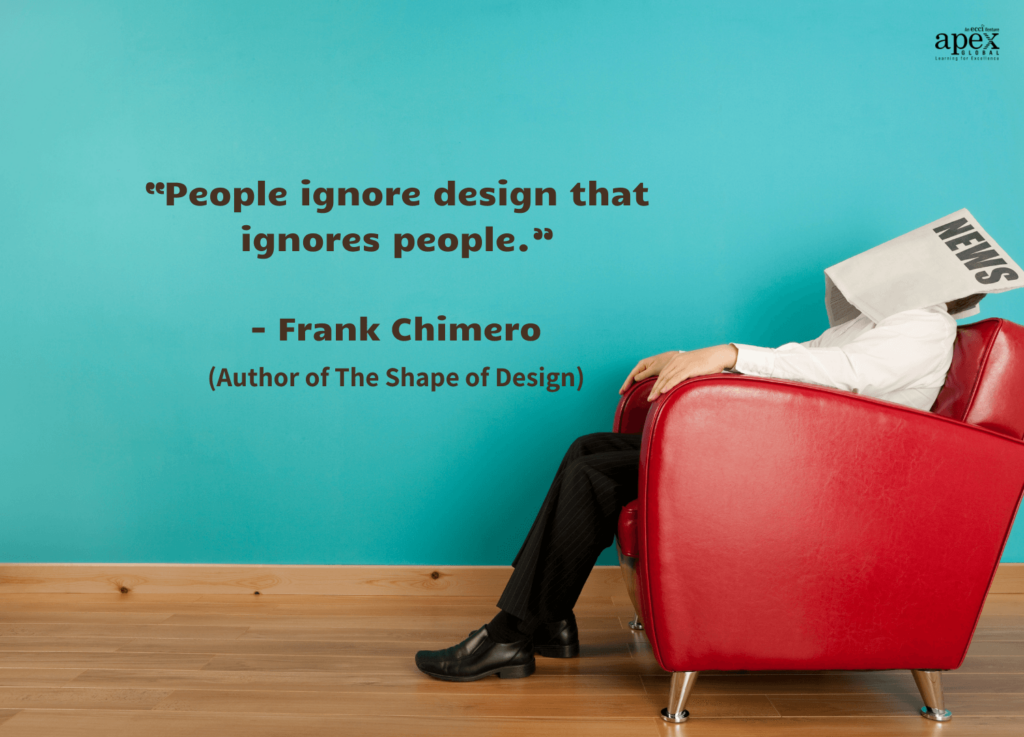
The first step in the design thinking process isn’t to look at the market, the features your product will have, or anything related to the product itself. The first thing you have to do is to focus on the user.
Most of you think you know your users, but do you really?
This phase encourages you to set aside your assumptions and gain real insight into users and their needs by empathizing with them.
During the empathize phase, you have to engage with and observe your target audience. Spend time watching how they work. What processes do they follow? What does the work environment look like?
Have them walk you through their daily activities as if you were job shadowing them. Do this with each person or persona that may interact with your end product to make sure you’re considering all perspectives.
As you observe, your most powerful tool is regularly asking the user “why”. This is important because their answers may reveal surprising insights that you wouldn’t have thought of your own while assuming yourself as a user.
The main aim is to develop the best possible understanding of your users, their needs, wants, pain points, expectations, challenges, etc.
For example, if you want to address the issue of employee retention in your organization, you can ask each employee to complete an anonymous survey. Then you can hold interviews with as many employees as possible to find out how they feel about retention within the company.
With first-hand knowledge, you’ll be able to design with the needs of actual users in mind. Learn more about empathy in design thinking here.
Stage 2: Define (What’s the problem?)
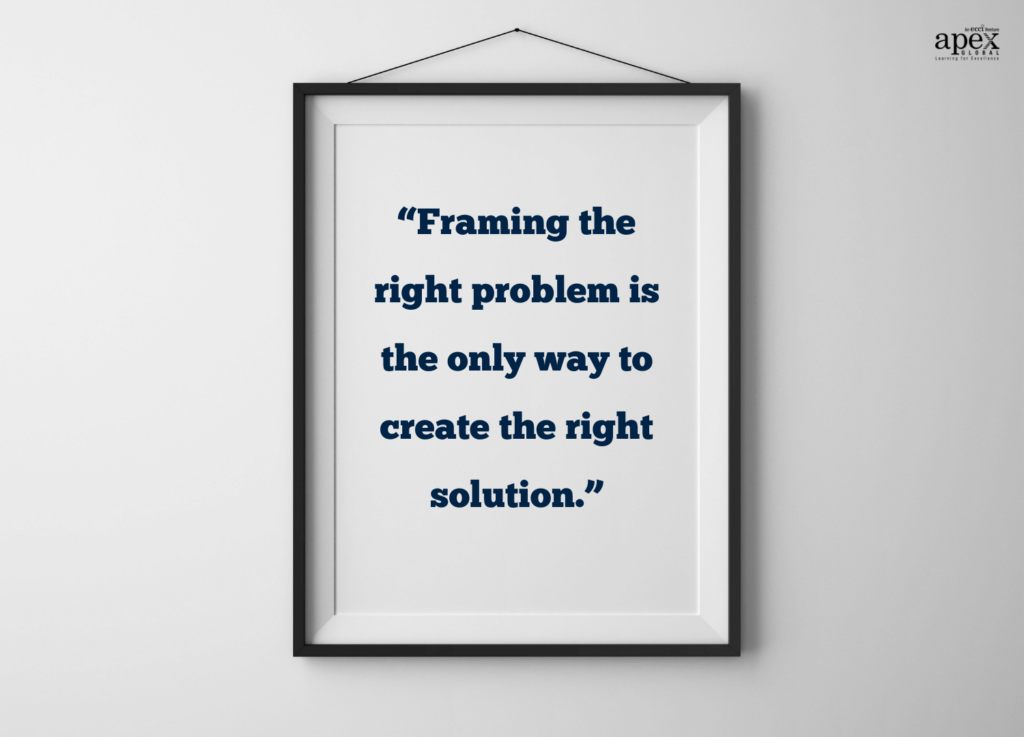
In the define phase, you have to craft a meaningful and actionable problem statement based on your user research.
Your problem statement should describe the specific problem you plan to solve. It will serve as a roadmap for the entire design process, providing you with a fixed goal to work towards and encouraging you to always keep the user in mind.
But how do you start framing your problem statement?
You can begin by considering what stood out to you when you were engaging with and observing people. Is there a common pain point across several different users? What solutions do your users currently use to solve that problem or pain point? Are certain expectations continually mentioned? Group these until you can identify what has to be addressed immediately.
Once you organize all your observations and draw parallels across your users’ current experiences, you will be able to define a specific problem statement.
Keep in mind that rather than framing your problem statement as a business goal, for example, “We need to increase gym membership among over-50s by 30%”, you have to frame it from the user’s point of view: “Over-50s in New York need flexible, affordable access to sports facilities in order to stay healthy and fit.”
Now, you are ready to proceed to the next stage of the design thinking process – ideation.
Stage 3: Ideate (How can we solve it?)
Ideate, the third phase of design thinking, is where you come up with innovative solutions to the problem statement you’ve created.
As users’ needs and pain points start to crystalize, it is now time for you to brainstorm potential solutions.
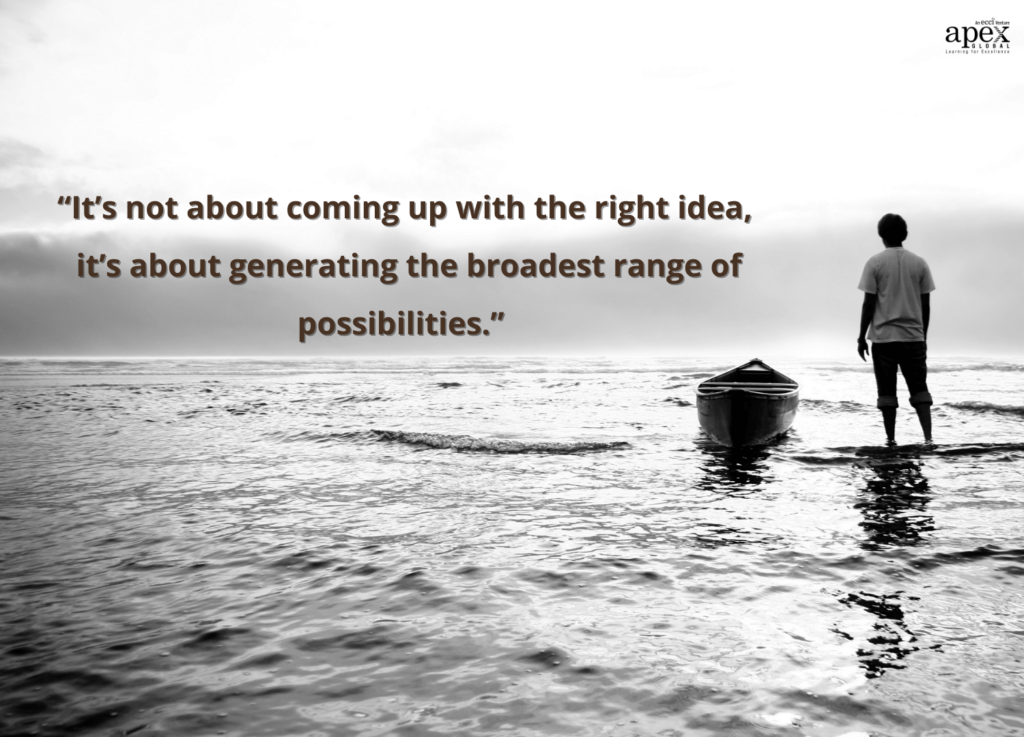
Come up with a range of crazy, creative ideas that address the unmet user needs that were identified in the define phase. Give yourself and your team total freedom. Keep in mind that no idea is a bad idea. By focusing on the quantity of ideas rather than quality, you’re more likely to free your mind and stumble upon innovation!
Once you are done generating ideas, narrow down and select the most feasible ones that you can pursue.
In our example of employee retention, based on what you’ve learned in the empathize and define phases, you will try to come up with as many ideas as possible on how to make your employees happier and, thus, more likely to stay with the company. Some possible ideas might include providing training to your employees, introducing stress management programs, etc.
Stage 4: Prototype (This is the representation of our idea)
Okay, so you have framed the problem and generated ideas. Now it’s time to get the winning ideas down into something tangible.
During this stage, you have to build prototypes which are “scaled-down” versions of the product or concept you want to test.
The prototype can be anything from a wall of Post-it notes or a storyboard to a functional replica of the product or an interactive activity.
Start by making quick, scrappy representations of ideas that they can interact with and give feedback easily.
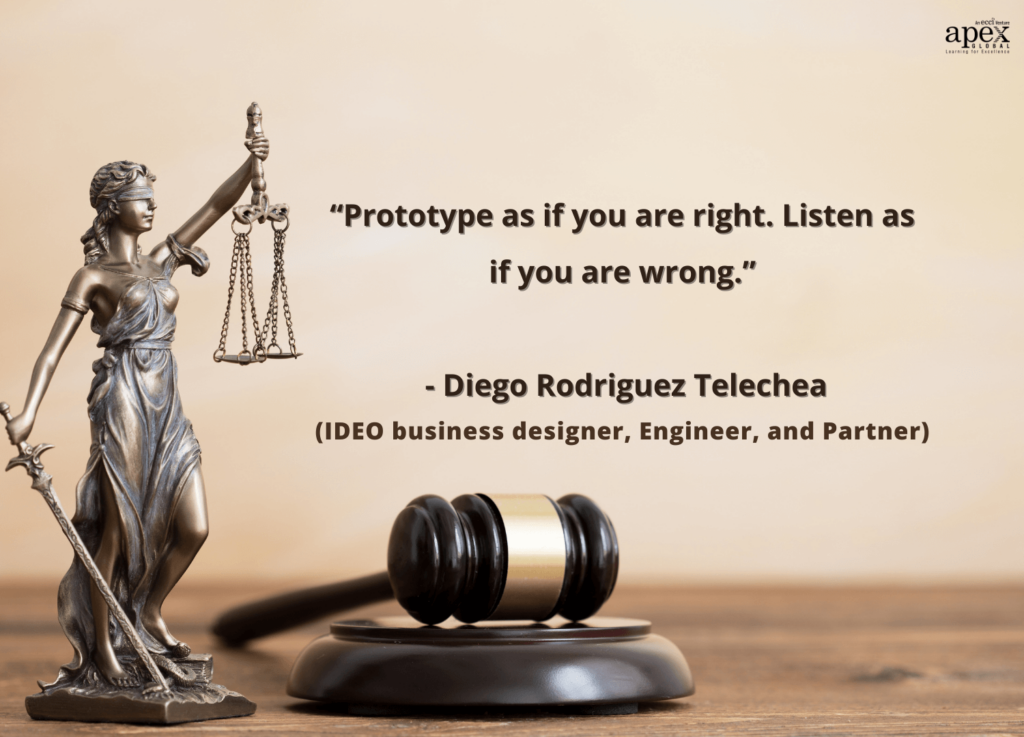
Staying low-res also allows you to pursue many different ideas without committing to a direction too early on.
In our employee retention example, let’s say during the ideation phase, one idea came up, which was to offer free yoga classes. To prototype this idea, you have to set up a dedicated yoga room in the office, complete with mats, water bottles, and hand towels.
This is crucial in maintaining a user-centric approach, allowing you to gather feedback before you go ahead and develop the whole product or implement the idea.
By the end of this stage, you will have a few prototypes that are ready to be tested. Learn more about prototyping in design thinking here.
Stage 5: Test (Does it work?)
This stage is all about sharing your prototype with real users to get their feedback.
Give the user the prototype you have created and don’t explain or elaborate on it. Leaving users in the dark will provide for legitimate reactions as people explore and use it for the very first time.
For a product, ask people to take it with them and use it within their normal routines. For an experience, bring people to the location where you have created the scenario and just let them be.
While gathering feedback, remember to ask open-ended questions that force the users to elaborate on their feelings, as opposed to simple yes or no questions.
By the end of this stage, you will have a better idea of the prototype’s limitations and also have a clearer view of how real users would behave, think, and feel when they interact with your product.
You should aim to get as much information from your users as possible so that you can modify the solution to best meet their needs.

In 2014, the Google Primer team released a stripped-down beta version of their educational app containing only 12 lessons that they then tested with select users. This helped the team improve both the UX and the content of the app before launching the official Primer app a year later.
At the end of this stage, you may have to revisit the empathize stage or run through a few more ideation sessions before you create that winning prototype.
15 great design thinking examples
Companies may be applying the design thinking approach but are any of them actually seeing results?
As they say, the proof is in the pudding. It’s time to see how businesses have employed this approach in a real-world setting.
The following design thinking examples show how some familiar companies and leading businesses in the world have tapped into design thinking to achieve great things.
Example #1: Airbnb
Airbnb, one of the biggest online rentals of hotel rooms, apartments, and homestays across the world, was once close to going bust.
The company was able to get traffic for its site but was unable to convert that into checkout despite having a diverse listing of properties in various categories & cities.
The company’s founders implemented the design thinking process to find out why their existing audience wasn’t using their services. They discovered that there was a common pattern in the pictures of the 40 ads published in New York: they weren’t very good.
Since the pictures were taken with smartphones, not all the rooms of the homes were shown, and those interested had no idea where they were going to live. People were not booking rooms because they couldn’t actually see what they were paying for.
So the Airbnb team traveled to New York, rented a camera, spent some time with customers listing properties, and replaced amateur photography with beautiful high-resolution pictures.
A week later, the results were in. The weekly revenue doubled to $400 per week after the pictures were improved. This was the first financial improvement that the business had seen in over eight months.
This massive improvement in the quality of their offering then led to customer retention, ultimately resulting in the growth of their customer base.
Thus, by using design thinking, the founders were able to transform their dwindling start-up into a thriving enterprise that revolutionized the travel industry.
Example #2: Uber Eats
Uber has established itself as one of the most successful companies, but it didn’t stop there. The company wanted to expand its business. They wanted people to get customized and affordable food delivery at the tap of a button.
By combining technology with food delivery, they created yet another service that keeps people coming back for more–Uber Eats.
But how did Uber Eats become successful?
Their design team is known for sticking to design thinking principles at every step of the product development process.
To understand their different markets, UberEats designers visit a city where the company operates and immerse themselves in the culture and infrastructure. They interview delivery partners, restaurant workers, and consumers to get feedback from every user.
They also perform “order shadowing”, where the designers can observe the process in action. This involves visiting restaurants during busy periods and actually sitting in customers’ homes when they order.
Additionally, they offer “fireside chats” with their customers to gain insights directly. They encourage open discussions about what matters to them the most by inviting delivery partners, restaurant staff, and customers into the Uber offices.
Thanks to design thinking, Uber Eats is now one of the top food delivery services in 24 countries across the world.
Example #3: The Good Kitchen
In 2007, over 125,000 elderly citizens in Denmark were relying on government-sponsored meals.
The Danish design agency Hatch and Bloom was called upon by the Municipality of Holstebro to design a new and improved meal delivery service for these citizens.
One of the most notable actions their team took was the decision to interview and prototype with both consumers and chefs.
By listening to their concerns, hearing their pain points, and testing out new options, they found the things that the meal recipients desired were similar to what the chefs requested—an improved service with a greater variety of food options.
What came to fruition was a service with improved quality, more freedom of meal choice, and more flexibility for the elderly citizens, the chefs, and other employees.
And the results?
There was a 500% increase in meal orders in the first week alone. The number of customers increased from 650 to 700 in just three months. The team received positive reactions from everywhere—users and partners and even from colleagues in other municipalities.
The Good Kitchen and the design agency also received the Danish Design Prize for Service Design, as well as the Local Government Denmark Prize for Innovation in 2009.
Example #4: Intuit
Intuit Inc. is a business software company in America that specializes in financial software.
It introduced a software solution in a market that was already saturated. But Intuit’s product ‘Quicken’ became massively popular and became the market leader in personal finance software and was able to hold that position for 30 years.
How was this possible? Yes, by implementing the design thinking process.
Through user research, they learned that most people hated complex spreadsheet-based solutions to track personal finances.
The research of competitors made it clear that while existing solutions were appropriate for professional accountants, the average user would find them difficult to use.
That’s when Intuit took inspiration from what their users were already familiar with to display their accounting data — a check register and an individual check instead of spreadsheets.
By changing the interface into something familiar and by making its software easy to use, Intuit was able to win over its competitors.
Example #5: Embrace
Every year, more than 1 million infants die on the day of their birth, according to Embrace Global.
The main cause of those deaths? Hypothermia. Due to premature and underweight births, infants in developing countries are more prone to hypothermia.
Even though there were many incubators in hospitals, they were mostly unused due to high prices and unequal distribution in urban & rural cities. It was a challenge for authorities & hospitals to provide low-cost incubation to newborn children.
A student team from Stanford University applied the design thinking process to find a solution to this problem.
They started by visiting hospitals in Nepal and quickly realized that the babies who needed the incubators were born in villages 30 miles away. They learned that no matter how well-designed the hospital incubators were, life-and-death battles were being fought in the mother’s home.
Thus, the team had to design a low-cost incubator that could be used anywhere. The solution they came up with was the Embrace Infant Warmer.
It’s a tiny sleeping bag containing a paraffin-based pouch that, once warmed in a heater, can maintain temperature for 4 hours. It helps regulate a newborn baby’s body temperature during the first few days of its life.
This infant warmer is easy to use and costs 99 percent less than a traditional baby incubator. It does not depend on electricity, is portable, and, above all, is safe.
With the help of Embrace Global and its partners, Embrace warmers have been used to care for over 200,000 low-birth weight and premature infants across 20 developing countries.
Example #6: Burberry
Burberry Group Inc. is a British luxury lifestyle fashion house established in 1856 with its headquarters in London.
The arrival of the internet era caused disruption to Burberry’s business strategy. It was already being dismissed as the fashion label of the bygone era.
In order to grow the company’s revenue, the new CEO Angela Arhendts understood that it needed to connect with the digital demographic. So, she and her team decided to appeal to Gen X users’ sentiments and behavior.
The company invested heavily in its social media strategy and invited users to collaborate on its design processes. It crafted a marketing strategy that connected with the values of a younger customer base, that was “cool and innovative,” and that could convince younger people to become loyal customers.
So what’s the return? Burberry created a social media space where customers and the company could freely contribute to new product launches and ideas. It not only drew in more customers but also improved the company’s reputation.
In the end, the company was able to increase its appeal by connecting with the right audience, leading to record revenue growth of up to $3 billion. Today Burberry is one of the most digitally innovative brands in the world and the most well-known brand on social media.
Example #7: Heinz
If you were to open your refrigerator at this very moment, chances are good that you would have an upside-down plastic bottle of Heinz ketchup.
However, this packaging design of the upside-down bottle didn’t enter the market until 2001. Heinz ketchup originally came in a glass bottle which was once a staple in family kitchens around the world.
What motivated the company to monumentally switch up its packaging design?
By the late 90s, sales of the condiment were declining, and the company wanted to see if this had anything to do with customers’ experiences using the product. User research helped the team identify that people were finding it troublesome to get ketchup out of the bottle and that they often stored their Heinz bottles upside down in the fridge.
Thus, based on that user insight, the Heinz team turned the problem, literally, on its head. The upside-down plastic ketchup bottle was born — it helped consumers get the product quicker, easier, and without making any mess.
Since then, customers have loved the packaging’s design for its convenience and ease of storage. And now, lots of our daily products are available in upside-down packaging e.g. toothpaste, shampoo, and pretty much all sauce bottles.
Example #8: Samsung
Soon after Samsung Electronics released its Galaxy S smartphone and Galaxy Tab tablet, the design team members noticed an unmet need in the market.
In Korea and Japan, many knowledge workers had a habit of jotting down notes and keeping their schedules in wallet-size pocket diaries, for which neither the four-inch phone nor the nine-inch tablet provided a good substitute.
From this user insight, they realized that a whole new platform was needed. The design team developed the concept of a smart diary that featured a pen interface and a five-and-a-half-inch screen.
It wasn’t just a bigger smartphone or a smaller tablet computer; this “phablet” met the needs of knowledge workers wanting to jot down ideas on the go.
And thus, the results eventually led to the highly successful Galaxy Note series… and it all started with the process of design thinking.
Example #9: Starwood
For a long time, the hospitality industry had been engaging in cut-throat competition in building low-cost business models that can give a price advantage to consumers.
Price has been a major deciding factor in both selection and booking, but can a superior experience convince regular consumers to pay more?
Starwood Hotels & Resorts Worldwide Inc. used design thinking as a strategy to reimagine the stay experience.
One of the biggest issues they solved was how to create a front desk with empathy that may make the hotel check-in experience less painful.
They spent two years developing a new system that radically speeds up check-in at its properties. While assigning a room once required 143 keystrokes on a terminal fixed behind the check-in counter, customers can now complete their check-in process with just three strokes on a tablet.
Other concepts created included redesigned guest rooms, leveraging social data for creating personalized experiences, smart fridges, etc. They also launched Starwood’s Starlab – an innovation space to use creativity and design to build next-generation experiences for travelers.
And the result?
Starwood has frequently won accolades for customer satisfaction and loyalty. Today, their revenues exceed USD 6 Billion and have one of the highest active subscribers of the loyalty program.
Example #10: Nike
When we hear about Nike, words that immediately come to mind are “running”, “sports”, “shoes”, etc.
But design thinking?
Yes. Nike was first finding it difficult to become a prominent brand in the skateboarding community. They had trouble gaining the same level of support given to brands like DC and Globe.
Nike decided to include skateboarders in the design process. During conversations with skateboarders, they tried to find out what the community was looking for in a skateboard company.
This strategy helped the team obtain a better overall understanding of the interests and needs of the skateboarding community.
After incorporating insights from customer involvement and the expertise of skateboard insiders on their design team, Nike unveiled the Nike Dunk SB.
Since releasing its Nike SB line of shoes, the company has experienced tremendous success within the skateboarding culture. And today, Nike is one of the most successful athletic brands in the world.
Example #11: Golden Gate Regional Center (GGRC)
Golden Gate Regional Center (GGRC) is a state- and federal-funded nonprofit organization serving individuals with developmental disabilities in Marin, San Francisco, and San Mateo counties.
The GGRC team was facing a serious problem in addressing the needs of the families of children with developmental disabilities. Before determining which services are best for a child, they have to conduct a thorough assessment that often took more than 3 months to complete.
The parents have to drag their children to a daunting series of meetings and examinations in unfamiliar new places, which distressed the children leading many parents to entirely abandon the process.
On Feb 14, 2014, two Stanford students visited the GGRC team, and together they tried to address this problem.
They brainstormed as a group and brought staff members into the same room so that they could visualize the way they were all connected within the process. The team took on the perspective of the clients and was able to see problems that they otherwise would have been blind to from the other side of the process.
After doing an experiment, the GGRC team learned valuable lessons about how they could improve the process for all clients. They also realized that it’s not just about one idea; it’s about the process of continuous improvement.
Several prototypes inspired by that day of the experiment have been launched and tested. One prototype led to the creation of a dedicated assessment team that redesigned numerous steps in the process to achieve the goal of completing the assessment within 45 days (a 50% reduction in time).
In the end, they were able to make numerous improvements. As a result, more customers opted into their service, and the team has been able to process the assessments much faster since then.
Example #12: S-OIL
Imagine yourself being fully decked up for a party containing all the enthusiasm to arrive on time, although when you reach the venue, all you get to discover is a long line of vehicles waiting in a queue.
That is the most frustrating part of the memory-making hours. Well, the S-Oil Corporation converted that painstaking experience into a plain sailing task.
S-Oil was a start-up gas station in South Korea a few years ago. They saw a challenge that drivers faced daily – it was hard to find an empty parking space. They were driving in circles and wasting time before finally finding an empty spot to park their cars.
The company studied the situation and noticed that an average driver went up to 15 extra kilometers per month, resulting in a vast amount of useless costs and wasted gas.
Using the design thinking process, the company came up with an elegant, low-cost solution. They proposed to put up yellow arrow balloons with the word “HERE” to show free spaces in the parking lot.
As a result, S-Oil took care of users, increased sales, and developed an image of a company that cares about the environment.
Example #13: Pixar & Disney
You must have definitely watched the popular film “Ratatouille”. In case you haven’t, this film is about Remy, a cute blue-coated rat who dreams of being a big chef in Paris.
Ratatouille was a massive international commercial success thanks to its unique and touching story.
So, how do Pixar & Disney come up with such amazing stories that always win people’s hearts? You guessed it — by applying the design thinking process.
In the case of Ratatouille, besides taking a thousand photos of the city of Paris as a reference, the movie director and R&D teams also reached out to people with expertise in their research areas. Together, they
- visited a woman who lives with 36 pet rats.
- asked chef Anthony Bourdain about his most memorable meal at a restaurant.
- hired chef Thomas Keller as a consultant on the film and shadowed dinner shifts at his restaurant, The French Laundry, to learn how kitchens in real French restaurants function.
This intense research enabled them to move forward to the prototyping and testing phase with a solid base and eventually created the successful movie that we know and love today.
Example #14: Life Saving Dot or Jeevan Bindi
“Jeevan Bindi” (Life Saving Dot) is one of the best examples of design thinking we have seen in the recent past, specifically in the health industry.
The challenge was to overcome iodine deficiency among women in rural India. Though there is iodized salt available in the market, it is expensive compared to non-iodine salt, and iodine tablets have availability problems.
Singapore-based philanthropic foundation Grey for Good used design thinking to come up with a solution to this problem. They learned that a lot of married women in India put this dot called “Bindi” on their foreheads.
Thus, Grey for Good collaborated with Neelvasant Medical Foundation and Research Center and Talwar Bindi to produce iodine patches in the form of ‘Bindis’.
These bindis auto-deliver iodine to the users through the forehead skin. Women just have to fix it on their forehead for the whole day, just like they do with the normal ‘Bindi’.
Till today, these bindis have helped more than 300,000 women in 100 villages fight iodine deficiency.
Example #15: IBM
In 2014, IBM executives decided to build a new application development platform for cloud computing.
The main goal was to help developers in big companies create cloud applications much faster.
The team tore up its product development playbook and developed a new approach called IBM Design Thinking to replace it.
In this new approach, their team began to apply design thinking at the speed and scale the modern enterprise demands. To compensate for the disconnect enterprises often experience between teams, stakeholders, and customers, IBM’s design thinking methodology prioritizes people and human connections throughout the process.
Researching the target audience and identifying their pains and needs allowed IBM to create an easy-to-use and functional platform called Bluemix (now IBM Cloud).
The platform attracted more than one million developers and emerged as one of the company’s most important software platforms.
Since then, in addition to Bluemix, the company has developed around 100 products using design thinking.
Want to check out another example? Learn how Singapore used design thinking to transform its government services here.
Wrapping up
In this blog post, we have seen what the design thinking process is and looked at 15 real-world design thinking examples.
With a focus on users’ needs and a desire to be customer-centric, these organizations have both turned profits and earned reputations for listening to what their customers need — and serving them.
So, don’t be afraid to take risks and immerse yourself in the lives of the people who will actually interact with your product. Then implement their feedback, create prototypes, and test your solutions. Eventually, you’ll land on that final iteration that has the potential to change the world around you. Learn more about how design thinking helps in a business here.
Interested in learning more about design thinking? We recommend attending a design thinking workshop. APEX Global’s Design Thinking Practitioner course includes more powerful real-world case studies and provides you with all the knowledge and experience you need to start practicing design thinking in your life.
Already implement design thinking into your work or business? Please get in touch and share your experiences with us. We’d love to hear from you!

